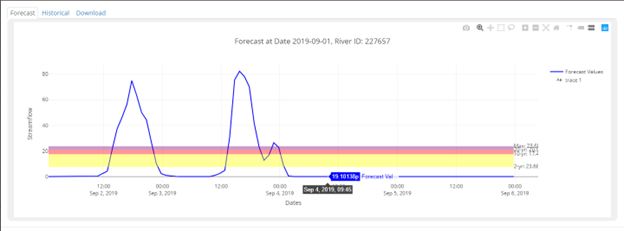Description
The Flash Flood Prediction Tool for Nepal provides 54-hour flash flood forecasts for
12,428 river segments in Nepal. The tool provides predicted estimates for flash floods
from localised extreme weather phenomena like convective storms and thunderstorms. It
uses the precipitation forecasts from the High-Impact Weather Assessment Toolkit (HIWAT)
as inputs into the Routing Application for Parallel computatIon of Discharge (RAPID)
hydrological model to estimate streamflow in the river network. This tool complements
information generated by the Streamflow Prediction Tool for Nepal and can be used as
part of a decision support system for flood forecasting services. It can assist decision
makers and managers in providing flood early warnings and response decisions during
extreme events in small river catchments.
Each river segment displayed in the map interface is colour-coded daily to indicate
streamflow in the segment with respect to flood return periods.
- Blue indicates river flow <= 2-year return period
- Yellow indicates river flow > 2-year return period
- Orange indicates river flow > 10-year return period
- Red indicates river flow > 20-year return period
Users can click on a particular river segment to display forecast information. Rivers
with streamflow exceeding the threshold level for higher return periods are likely to
experience flooding.
Methodology
The Flash Flood Prediction Tool for Nepal provides predicted estimates by routing HIWAT
runoff predictions through the RAPID model. HIWAT combines innovative numerical weather
prediction, satellite-based precipitation, and land imagery techniques to assess the
potential threats and impacts of high-impact convective weather events. Different
proprietary and open-source GIS tools are used to generate the connections between
predicted and hindcasted runoff.
The SERVIR Hindu Kush Himalaya (SERVIR-HKH) Initiative at ICIMOD worked together with
Brigham Young University and NASA’s Marshall Space Flight Center to develop the
customised Flash Flood Prediction Tool (earlier referred to as the HIWAT Streamflow
Prediction Tool) for Nepal. It is built on Tethys, an open-source platform for water
resources web app development. The Department of Hydrology and Meteorology (DHM),
Government of Nepal, provided data on station locations with names. Observational data
from selected stations are being used for forecast verification.
HIWAT runs on the SERVIR Operational Cluster Resource for Applications – Terabytes for
Earth Science (SOCRATES) platform during the pre-monsoon and monsoon season from March
to September every year.
Analytical tools
The web application displays the following layers, which can be toggled on and off:
- Outline
- District-level administrative layer of Nepal
- River network and river names
- DHM station locations with names
Users can view the following parameters upon clicking on any river stretch:

Forecast (54-hour): Forecast information is generated from nine ensemble forecasts and
shows the forecasted streamflow for a given period. The different background colours in
the graph represent the flow magnitude between defined return periods.
Users can further interact with adjoining tabs to access the following:
Historical: This tab displays a graph of simulated historical flow from 1980 onwards based on
ERA5 data.
Download: This tab allows users to download the forecast and historical data a downloadable CSV file.
For more information, please visit
https://servir.icimod.org/science-applications/flash-flood-prediction-tool-nepal/
Feedback
We value your feedback. Please write to servirhkh@icimod.org